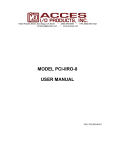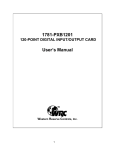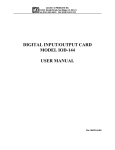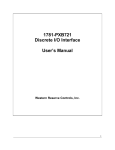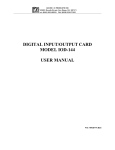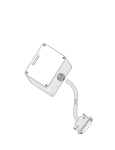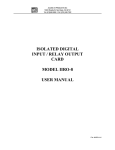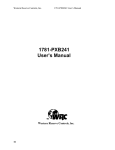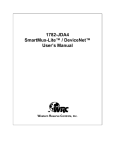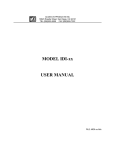Download 1781-PXB481 manual for 48-point Digital Input/Output Card
Transcript
1781-PXB481 48-POINT DIGITAL INPUT / OUTPUT CARD USER'S MANUAL Rev. 2.E2a Western Reserve Controls, Inc. 1485 Exeter Road Akron OH 44306 330-733-6662 330-733-6663 (FAX) [email protected] (Email) http://www.wrcakron.com (Web) 1781-PXB481 USER'S MANUAL _____________________________________________________________________________________________ NOTICES The information in this document is provided for reference only. WRC does not assume any liability arising out of the application or use of the information or products described herein. This document may contain or reference information and products protected by copyrights or patents and does not convey any license under the patent rights of WRC, nor the rights of others. WRC is a trademark of Western Reserve Controls, Inc. IBM PC, PC/XT, and PC/AT are registered trademarks of the International Business Machines Corporation. Other trademarks belong to their respective companies. 1781-PXB481 USER'S MANUAL _____________________________________________________________________________________________ TABLE OF CONTENTS INSTALLATION . . . . . . . . . . . . . . . . . . . . . . . . . . . . . . . . . . . . . . . . . . BACKING UP THE DISK . . . . . . . . . . . . . . . . . . . . . . . . . . . . HARD DISK USERS . . . . . . . . . . . . . . . . . . . . . . . . . . . . . . . . INSTALLING THE CARD . . . . . . . . . . . . . . . . . . . . . . . . . . . 2 2 2 2 FUNCTIONAL DESCRIPTION . . . . . . . . . . . . . . . . . . . . . . . . . . . . . BLOCK DIAGRAM . . . . . . . . . . . . . . . . . . . . . . . . . . . . . . . . 5 4 OPTION SELECTION . . . . . . . . . . . . . . . . . . . . . . . . . . . . . . . . . . . . . OPTION SELECTION MAP . . . . . . . . . . . . . . . . . . . . . . . . . 7 6 ADDRESS SELECTION . . . . . . . . . . . . . . . . . . . . . . . . . . . . . . . . . . . . ADDRESS ASSIGNMENTS FOR PC AND PC/XT . . . . . . . ADDRESS ASSIGNMENTS FOR 286/386/486 . . . . . . . . . . 8 8 9 SOFTWARE . . . . . . . . . . . . . . . . . . . . . . . . . . . . . . . . . . . . . . . . . . . . . . 11 PROGRAMMING . . . . . . . . . . . . . . . . . . . . . . . . . . . . . . . . . . . . . . . . ADDRESS SELECTION TABLE . . . . . . . . . . . . . . . . . . . . . . . CONTROL REGISTER BIT ASSIGNMENT . . . . . . . . . . . . . . CHANGE-OF-STATE-INTERRUPT-ENABLE REGISTER . . ENABLING/DISABLING I/O BUFFERS . . . . . . . . . . . . . . . PROGRAMMING EXAMPLE . . . . . . . . . . . . . . . . . . . . . . . . . 12 12 13 13 13 14 CONNECTOR PIN ASSIGNMENT . . . . . . . . . . . . . . . . . . . . . . . . . . . 16 SPECIFICATION . . . . . . . . . . . . . . . . . . . . . . . . . . . . . . . . . . . . . . . . . 17 APPENDIX A . . . . . . . . . . . . . . . . . . . . . . . . . . . . . . . . . . . . . . . . . . . . . 18 APPENDIX B . . . . . . . . . . . . . . . . . . . . . . . . . . . . . . . . . . . . . . . . . . . . . 20 1781-PXB481 USER'S MANUAL _____________________________________________________________________________________________ INSTALLATION BACKING UP THE DISK Software is provided with the 1781-PXB481. As with any software package, you should make backup copies for everyday use and place the master diskette in a safe location. The easiest way to make a backup copy is to use the DOS DISKCOPY utility. In a single-drive system the command is: DISKCOPY A: A: In a two-disk system the command is: DISKCOPY A: B: This will copy the contents of the master disk in drive A to the backup disk in drive B. HARD DISK INSTALLATION The files contained on the master diskette may also be copied onto your hard disk. To do this perform the following: 1) 2) 3) Place the master diskette into a floppy drive. Change the active drive to the drive that has the master diskette installed. For example, if the diskette is the A drive, type A:. Type INSTALL and follow the screen prompts. Files contained on the disk are stored in separate as follows: ROOT DIRECTORY: PSAMPLES: CSAMPLES BSAMPLES: VB_WRC: Contains the FINDBASE PROGRAM that will help you to decide what base address to use with the card. Also contains the 1781-PXB481 setup program. Contains Pascal samples and the Pascal-linkable driver. Contains “C” samples and a “C”-linkable driver. Contains the BASIC and QuickBASIC samples as well as the binary and linkable drivers. Contains a VisualBASIC sample as well as a VisualBASIC linkable driver. INSTALLING THE CARD Before installing the card carefully read the ADDRESS SELECTION and OPTION SELECTION Sections of this manual and configure the card according to your requirements. Use the special software program called PXB481ST provided on diskette with the card. It supplies visual aids to configure all areas of the board. 2 1781-PXB481 USER'S MANUAL _____________________________________________________________________________________________ Be especially careful with address selection. If the addresses of two installed functions overlap, you will experience unpredictable computer behavior. If unsure what locations are available, you can use the FINDBASE program provided on our diskette to locate blocks of available addresses. To install the card: 1. Remove power from the computer. 2. Remove the computer cover. 3. Remove blank I/O backplate. 4. Install jumpers for selected options. See OPTION SELECTION 5. Select the base address on the card. See ADDRESS SELECTION 6. Loosen the nuts on the strain relief bar and swing top end free. 7. Install the card in an I/O expansion slot. If convenient, select a slot adjacent to a vacant slot because this will make cable installation easier. 8. Thread the I/O cables, one by one, through the cutout in the mounting bracket and plug them into the headers. 9. Smooth the cables as close as possible to the card and, while holding them close to the surface of the card, swing the strain relief bar into position and tighten nuts. 10. Inspect for proper fit of the card and cables and tighten screws. 11. Replace the computer cover. 3 1781-PXB481 USER'S MANUAL _____________________________________________________________________________________________ FUNCTIONAL DESCRIPTION FEATURES 48 Bits of Digital Input/Output Interrupt Generation on Input Change-of-State Change-of-state Interrupt Software Enables in Six 8-Input Ports All 48 I/O Lines Buffered on the Board I/O Buffers Can Be Enabled/Disabled under Program Control Four and Eight Bit Ports Independently Selectable for I/O Pull-Ups on I/O Lines +5V Supply Available to the User Compatible with Industry Standard I/O Racks from WRC, and other vendors like Gordos, Opto-22, Potter & Brumfield, etc. APPLICATIONS Automatic Test Systems Laboratory Automation Robotics Machine Control Security Systems, Energy Management Relay Monitoring and Control Parallel Data Transfer to PC Sensing Switch Closures or TTL, DTL, CMOS Logic Driving Indicator Lights or Recorders A major feature of this card is that the state of all inputs can be monitored and, if any one or more bits change state, a latched interrupt request can be generated. Thus, it is not necessary to use software to continuously poll the inputs to detect a change of state. The change-of-state interrupt is enabled by a software write to an interrupt-enable register. Six bits in that register each control an eight-input port at one of two type 8255-5 Programmable Peripheral Interface chips. The change-of-state interrupt latch can be cleared by a software write. In addition, bit C3 at each 24-bit port (pin 9 on the connectors) can also be used as an interrupt to the computer if jumpers are installed. When bit C3 goes high (edge triggering), an interrupt is requested. Interrupts from these bits are OR’ed together and OR’ed with the change-of-state interrupt. Interrupts are directed to levels #2 through #7, #10 through #12, #14 and #15 by jumper installation. If enabled via the jumper, each of these two interrupts are designed to allow one signal in each group of 24 signals to act as an interrupt without regard to the interrupt status of the other 23 signals. The functional difference to the user is that these two lines interrupt only on high-going signals. The 1781-PXB481 card was designed for industrial applications and can be installed in 7”, or longer, I/O slots of IBM PC/XT/AT or compatible computers. Each I/O line is buffered and capable of sourcing 15 mA or sinking 24mA (64 mA on request). The card contains two Programmable Peripheral Interface chips type 8255-5 (PPI) to provide computer interface to 48 I/O lines. Each PPI provides three 8-bit ports A, B, and C. Each 8-bit port can be software configured to function as either inputs or output latches. Port C can also be configured as four inputs and four output latches. 4 1781-PXB481 USER'S MANUAL _____________________________________________________________________________________________ Tri-state I/O line buffers (74LS245) are configured automatically by hardware logic for input or output use according to direction assignment from a control register in the PPI. Further, if a jumper is properly placed on the card, the tri-state buffers may be enabled/disabled under program control. (See the Option Selection section to follow.) I/O wiring connections are via 50-pin headers on the board. Two flat I/O cables connect 1781-PXB481 to mounting boards, such as WRC’s 1781-A24A. Every second conductor of the flat cables is grounded to minimize the effect of crosstalk between signals. If needed for external circuits, +5 VDC power is available on each I/O connector pin 49. If you use this power, we recommend that you include a 1A fast-blow fuse in your circuits in order to avoid possible damage to the host computer or cable in the event of a malfunction in those external circuits. The 1781-PXB481 occupies sixteen bytes of I/O address space. The base address is selectable via a DIP switch anywhere within the range of 000-3FF hex. An illustrated setup program is provided on diskette with the 1781-PXB481 card. Interactive displays show locations and proper settings of DIP switches and jumpers to set up board address, interrupt levels, and interrupt enable. Also, sample programs in Turbo-C and Turbo-Pascal are presented in the Software section of this manual. 5 1781-PXB481 USER'S MANUAL _____________________________________________________________________________________________ OPTION SELECTION Refer to the setup programs on the diskette provided with the card. Also, refer to the 1781-PXB481 BLOCK DIAGRAM SCHEMATIC on the previous pages and the OPTION SELECTION MAP on the following page when reading this Section of the manual. External Interrupts are accepted on the I/O connector pin 9 (port C, bit 3). The Interrupt signal is positive true. These External Interrupts are enabled if the IEN jumper is installed. Interrupts are directed to levels #2 through #7, #10 through #12, #14 and #15 by jumpers installed locations labeled IRQ2 through IRQ7, IRQ10 through IRQ12, IRQ14 and IRQ15, respectively. A means of enabling or disabling the 74LS245 input/output buffers under program control is provided at the jumper position labeled TST/BEN. When the jumper is in the BEN (Buffer Enable) position, the I/O ;buffers are always enabled. When the jumper is in the TST (Tristate) position, enabled/disabled state is controlled by a control register. (See the programming section of this manual for a description.) An LED, CR1, is provided at the top-center of the card to assist you in program development. Each time an interrupt is generated, the LED will illuminate and remain on until the interrupt is reset. If there is an immediate reset of the interrupt, it is likely that the LED will not remain on long enough to be observed. NOTE A jumper must be installed either the TST or the BEN position for the card to function. There is a wire jumper installed on the card at a position labeled WAIT. The associated circuitry asserts a WAIT signal to the CPU in order to provide a longer write cycle. In this way, there is assurance that the 8255 PPI will have adequate time to accept inputs from the CPU in fast AT computers. If this extra wait state will cause a problem in your application and if you deem it non-essential, then this wire jumper may be clipped. The foregoing are the only manual setups necessary to use the 1781-PXB481. Input/Output selection and the change-of-state Interrupt Enable is done via software by writing to a control register in each PPI as described in the PROGRAMMING section of this manual. 6 1781-PXB481 USER'S MANUAL _____________________________________________________________________________________________ ADDRESS SELECTION The 1781-PXB481 card occupies 16 bytes of I/O space. The card base address can be selected anywhere within the I/O address range 100-3F0 hex in AT’s (except 1F0 to 1F8) and 200-3F0 in XT’s. However two installed options cannot share the same address. If in doubt where to assign the base address, refer to the following tables and the FINDBASE program to find an available address for your system. TABLE 1. STANDARD ADDRESS ASSIGNMENTS FOR PC AND PC/XT COMPUTERS Hex Range 000-00F 020-021 040-043 060-063 080-083 0AX 0CX 0EX 100-1FF 200-20F 210-217 220-24F 278-27F 2F0-2F7 2F8-2FF 300-31F 320-32F 378-37F 380-38C** 380-389** 3A0-3A9 3B0-3BF 3C0-3CF 3D0-3DF 3E0-3E7 3F0-3F7 3F8-3FF Usage DMA Chip 8237A-5 Interrupt 8259A Timer 8253-5 PPI 8255A-5 DMA Page Register NMI Mask Register Reserved Reserved Not Usable Game Control Expansion Slot Reserved Reserved Reserved Asynchronous Communication (secondary) Prototype Card Fixed Disk Printer SDLC Communications Binary Synchronous Comm. (secondary) Binary Synchronous Comm. (primary) IBM Monochrome Display/Printer Reserved Color/Graphics Reserved Diskette Asynchronous Communication (primary) ** These options can not be used together - addresses overlap 7 1781-PXB481 USER'S MANUAL _____________________________________________________________________________________________ TABLE 2. STANDARD ADDRESS ASSIGNMENTS FOR 286/386/486 COMPUTERS Hex Range 000-01F 020-03F 040-05F 060-06F 070-07F 080-09F 0A0-OBF 0C0-0DF 0F0 0F1 0F8-0FF 1F0-1F8 200-207 278-27F 2F8-2FF 300-31F 360-36F 378-37F 380-38F 3A0-3A9 3B0-3BF 3C0-3CF 3D0-3DF 3F0-3F7 3F8-3FF Usage DMA Controller 1 INT Controller 1, Master Timer 8042 Keyboard Real Time Clock, NMI Mask DMA Page Register INT Controller 2 DMA Controller 2 Clear Math Coprocessor Busy Reset Coprocessor Arithmetic Coprocessor Fixed Disk Game I/O Parallel Printer Port 2 Asynchronous Communication (secondary) Prototype Card Reserved Parallel Printer Port 1 SDLC or Binary Synchronous Communications 2 Binary Synchronous Communications 1 IBM Monochrome Display/Printer Local Area Network Color/Graphics Monitor Diskette Controller Asynchronous Communication (primary) To set desired board addresses, refer to the illustrated Board Address setup program on the Utility diskette provided with the card. Type the desired address in hexadecimal code and the graphic display will show you how to set the ADDRESS SETUP switches. These switches are marked A4-A9 and form a binary representation of the address in negative-type logic. (Assign '0' to all ADDRESS SETUP switches turned ON, and assign '1' to all ADDRESS SETUP switches turned OFF.) Switch Identification Address Line Controlled A9 A9 A8 A8 8 A7 A7 A6 A6 A5 A5 A4 A4 1781-PXB481 USER'S MANUAL _____________________________________________________________________________________________ The following example illustrates switch selection corresponding to hex 2D0 (or binary 10 1101 xxxx). The "xxxx" represents address lines A3, A2, A1, and A0 used on the card to select individual registers at the PPI's. See section 3, PROGRAMMING. Hex representation Conversion multipliers Binary representation Setup Switch ID. (label) 2+0=2 (hex) 2 1 1 0 OFF ON A9 A8 8+4+0+1=13=D(hex) 8 4 2 1 1 0 OFF OFF ON A7 A6 A5 CAUTION Carefully review the address selection reference table on the previous page before selecting the card address. If the address of two installed functions overlap you will experience unpredictable computer behavior. 9 1 1 OFF A4 1781-PXB481 USER'S MANUAL _____________________________________________________________________________________________ SOFTWARE WRC supplies three programs to support the 1781-PXB481 Digital I/O card and, also, to help you develop your applications software. These programs are on a diskette that comes with your card and are as follows: *PXB481ST This is a menu-driven, pictorial program to help you set the card address, interrupt level, change-of-state interrupt, and high level interrupt enable. *FINDBASE Reports active and available address locations in your computer for assignment as the 1781-PXB481 base address. *SAMPLE1.C This program is under a directory titled CSAMPLES. It is a C-language software program that demonstrates how to program the change-of-state function. *PXB48 This is a demonstration program which is listed under a directory titled *VB_WRC This directory contains a VisualBASIC sample and a .DLL to create VisualBASIC applications with the 1781-PXB481. DEMO. PXB481ST This program is supplied with the 1781-PXB481 as a tool for you to use in configuring jumpers and switches on the card. It is menu-driven and provides pictures of the card on the computer monitor. You make simple keystrokes to select functions. The picture on the monitor then changes to show how the jumper or switches should be placed to effect your choices. The setup program is a stand-alone program that can be run at any time. It does not require that the card be plugged into the computer for any part of the setup. The program is self-explanatory with operation instructions and on-line help. To run this program, at the DOS prompt, enter PXB481ST followed by the [Enter]. 10 1781-PXB481 USER'S MANUAL _____________________________________________________________________________________________ PROGRAMMING The 1781-PXB481 is an I/O-mapped device that is easily configured from any language and any language can easily perform digital I/O through the card’s ports. This is especially true if the form of the data is byte or word wide. All references to the I/O ports would be in absolute port addressing. However, a table could be used to convert the byte or word data ports to a logical reference. DEVELOPING YOUR APPLICATION SOFTWARE If you wish to gain a better understanding of the programs on diskette, then the information in the following paragraphs will be of interest to you. Refer to the data sheets and 8255-5 specification in Appendix A. A total of 16 address locations are used by the 1781-PXB481. The PPI’s are addressed consecutively with Address bits A3 through A0 as follows: TABLE 3. ADDRESS SELECTION TABLE Address Base Address +0 Base Address +1 Base Address +2 Base Address +3 Base Address +4 Base Address +5 Base Address +6 Base Address +7 Base Address +8 Base Address +9 Base Address +B Base Address +F Port Assignment PA port 0 PB port 0 PC port 0 Control port 0 PA port 1 PB port 1 PC port 1 Control port 1 Enable/Disable Buffer, Group 0 Enable/Disable Buffer, Group 1 Enable Chg-of-State Interrupt Clear Chg-of-State Interrupt Operation Read/Write Read/Write Read/Write Write Only Read/Write Read/Write Read/Write Write Only Write Only Write Only Write Only Write Only The 1781-PXB481 card uses two 8255-5 PPI’s to provide a total of 48 bits input/output capability. The card is designed to use each of these PPI’s in Mode 0 wherein: a. b. c. d. There are two 8-bit ports (A and B) and two 4-bit ports (C HI and C LO). Any port can be configured as an input or an output. Outputs are latched. Inputs are not latched. Each PPI contains a control register. This write-only, 8-bit register is used to set the mode and direction of the ports. At Power-Up or Reset, all I/O lines are set as inputs. Each PPI should be configured during initialization by writing to the control registers even if the ports are only going to be used as inputs. Output buffers are automatically set by hardware according to the control register state. Note that control registers 11 1781-PXB481 USER'S MANUAL _____________________________________________________________________________________________ are located at base address +3 and base address +7. Bit assignments in each of these control registers are as follows: TABLE 4. CONTROL REGISTER BIT ASSIGNMENT Bit D0 D1 D2 D3 D4 D5, D6 Assignment Port C LO (C0-C3) Port B Mode Select Port C Hi (C4-C7) Port A Mode Select D7 Mode Set Flag Code 1 = Input, 0 = Output 1 = Input, 0 = Output 1 = Mode 1, 0 = Mode 0 1 = Input, 0 = Output 1 = Input, 0 = Output 01 = Mode 1, 00 = Mode 0, 1X = Mode 2 1 = Active Note: Mode 1 and Mode 2 cannot be used by the 1781-PXB481 without modification (Consult Thus, bits D2, D5, and D6 should always be set to “0” and bit D7 to “1”. factory). At Power-Up or Reset, the change-of-state interrupt-enable register is set to zero. This enables all inputs to generate change-of-state interrupts. During initialization this register should be programmed to prevent interrupt generation by ports programmed as outputs or by inputs that you do not want to cause change-ofstate interrupts. In order to program the change-of-state interrupt-enable register, write to it at base address +B. Data bits D0 through D5 are used to enable inputs corresponding to ports A, B, and C of the 8255 PPI’s. Writing a “one” disables the port; writing a “zero” enables it. TABLE 5. CHANGE-OF-STATE-INTERRUPT-ENABLE REGISTER Bit D0 D1 D2 D3 D4 D5 Port Controlled Group 0, Port A Group 0, Port B Group 0, Port C Group 1, Port A Group 1, Port B Group 1, Port C The change-of-state interrupt is latched. To clear this latch, write anything at location (Base Address +F). ENABLING/DISABLING I/O BUFFERS 1781-PXB481 provides a means for enabling/disabling the tri-state I/O buffers under program control. If the TST/BEN jumper on the card is installed in the BEN position, the I/O buffers are permanently enabled. However, if that jumper is in the TST position, the buffers are software controlled via the control register as follows: a. The card is initialized in the receive mode by the computer reset command. 12 1781-PXB481 USER'S MANUAL _____________________________________________________________________________________________ b. When bit D7 of the control register is set high, direction of the three ports of the associated PPI chip as well as the mode can be set. For example, a write to base address +3 with data bit D7 high allows programming of port direction at Group 0 ports A, B, and C. If, for example, hex 80 is sent to base address +3, the PPI will be configured in mode 0 with Ports A, B, and C as outputs. c. Now, if any of the ports have been set as outputs, you may set the initial values to the respective port with the outputs still in the tri-state condition. (If all have been set as inputs, this step is not necessary). Group 0 ports d. If data bit D7 is low when the control byte is written, ONLY the associated buffer controller is addressed. If, for example, a control byte of hex 80 has been sent as previously described, and the data to be output are correct, and it is now desired to open the three ports, then it is necessary to send a control byte of hex 00 to base address +3 to enable the Group 0 buffers. When you do this, the buffers will be enabled. NOTE Note that all data bits except D7 must be the same for the two control bytes Those buffers will now remain enabled until another control byte with data bit D7 high is sent to base address +3. Similarly, the Group 1 ports can be enabled/disabled via the control register at base address +7. the following program fragment in C language illustrates the foregoing: const BASE_ADDRESS +3, 0x300; outportb(BASE_ADDRESS +3, 0x89); outportb(BASE_ADDRESS, 0); outportb(BASE_ADDRESS+1, 0); outportb(BASE_ADDRESS +3, 0x09); /*This instruction sets the mode to Mode 0, ports A and B as output, and port C as input. Since bit D7 is high, the output buffers are set to tri-state condition. See item b. above.*/ /*These instructions set the initial state of ports A and B to all zeroes. Port C is not set because it is configured as an input. See item c. above.*/ /*Enable the tri-state output buffers by using the same control byte used to configure the PPI, but now set bit D7 low. See item d. above.*/ PROGRAMMING EXAMPLE (BASIC) The following example in BASIC is provided as a guide to assist you in developing your working software. In this example, the card base address is 2D0 hex and the I/O lines of group 0 are to be setup as follows: 13 1781-PXB481 USER'S MANUAL _____________________________________________________________________________________________ Port A = Input Port B = Output Port C Hi = Input Port C Lo = Output The first step is to configure the control register. Configure bits of the control register as: D7 D6 D5 D4 D3 D2 D1 D0 1 0 0 1 1 0 0 0 Port C Lo= output Port B= output Mode 0 Port C Hi= input Port A= input Mode 0 Mode 0 Active Mode Set This corresponds to 98 hex. If the card address is 2DO hex, use the BASIC OUT command to write to the control register as follows: 10 20 BASEADDR=&H2DO OUT BASEADDR+3, &H98 To read the inputs at Port A and the upper nibble of Port C: 30 40 X=INP(BASEADDR) Y=INP(BASEADDR+2)/16 'Read Port A 'Read Port C Hi To set outputs high(1) at port B and the lower nibble of Port C: 50 60 OUT BASEADDR+1 ,&HFF OUT BASEADDR +2, &HF 'Turn on all Port B Bits 'Turn on all bits of Port C lower nibble 14 1781-PXB481 USER'S MANUAL _____________________________________________________________________________________________ CONNECTOR PIN ASSIGNMENTS Two 50-pin headers are provided on the 1781-PXB481; one for each 24 I/O group. The mating connector is an AMP type 1-499776-0 or equivalent. Connector pin assignments are listed below. Notice that every second line is grounded to minimize crosstalk between signals. ASSIGNMENT Port C High Port C High Port C High Port C High PC7 PC6 PC5 PC4 PIN PIN ASSIGNMENT 1 3 5 7 2 4 6 8 GROUND GROUND GROUND GROUND Port C Low PC3 ** Port C Low PC2 Port C Low PC1 Port C Low PC0 9 10 GROUND 11 13 15 12 14 16 GROUND GROUND GROUND Port B Port B Port B Port B Port B Port B Port B Port B PB7 PB6 PB5 PB4 PB3 PB2 PB1 PB0 17 19 21 23 25 27 29 31 18 20 22 24 26 28 30 32 GROUND GROUND GROUND GROUND GROUND GROUND GROUND GROUND Port A Port A Port A Port A Port A Port A Port A Port A PA7 PA6 PA5 PA4 PA3 PA2 PA1 PA0 33 35 37 39 41 43 45 47 34 36 38 40 42 44 46 48 GROUND GROUND GROUND GROUND GROUND GROUND GROUND GROUND 49 50 GROUND + 5VDC ** Note: This line is an I/O port and also a User Interrupt. 15 1781-PXB481 USER'S MANUAL _____________________________________________________________________________________________ SPECIFICATION Features 48 Bits of Digital Input/Output. Interrupt Generation on Input Change-of-State. Change-of-State Interrupt Software Enabled in Six 8-Input Ports. All 48 I/O Lines Buffered on the Board. I/O Buffers Can Be Enabled/Disabled under Program Control. Four and Eight Bit Ports Independently Selectable for I/O. 10kΩ Pull-Ups on I/O Lines. +5V Supply Available to the User. Compatible with Industry Standard I/O Racks like Gordos, Opto-22, Potter & Digital Inputs (TTL Compatible) Logic High: 2.0 to 5.0 VDC. Logic Low: -0.5 to +0.8 VDC. Input Load (Hi): 20 uA. Input Load (Lo): -200 uA. Digital Outputs Logic High: 2.5 VDC min., source 15 mA. Logic Low: 0.5 VDC max., sink 24 mA. (64 mA optional) Power Output: +5 VDC from computer bus (ext. 1A fast-blow fuse recommended). Power Required: +5 VDC at 200 mA typical. Size: 7.15” Long. Environmental: Operating Temperature: 0 degr. to 60 degr. C. Storage Temperature: -50 degr. to +120 degr. C. Humidity: 0 to 90% RH, non-condensing. 16 Brumfield, etc. 1781-PXB481 USER'S MANUAL _____________________________________________________________________________________________ ADDENDIX A WHEN YOU WISH TO USE THIS CARD WITH VISUALBASIC WRC provides extensions to the VisualBASIC language on the diskette provided with your card. The extensions are in a directory named VB_WRC. These extensions are in the form of a .DLL, a .GBL, a .BAS, and a .LIB file. Together these files allow you to access the port memory space in a fashion similar to BASIC, QuickBASIC, Pascal, C, C**, Assembly, and most other standard languages. To use these files in a VisualBASIC program, you must create a .MAK file (File 1 New Project) similar to the sample provided (or else, modify your existing project file to include the .GBL file). Once this has been done, VisualBASIC will be enhanced with the addition of four functions. Those functions and their calling method are listed below. InPortb Function: Reads a byte from a hardware port. Due to limitations of VisualBASIC, the number is returned in an integer. Declaration: function InPortb (byval address as integer) as integer InPort Function: Reads an integer from a hardware port. This function returns the 16-bit value obtained from reading the low byte from address and the high byte from address+1. Declaration: function InPort (byval address as integer) as integer OutPortb Function: Writes the lower eight bits of value to the hardware port at address. This function returns the value output. Declaration: function OutPortb (byval address as integer, byval value as integer) as integer OutPort Function: Writes all 16 bits of value to the hardware port at address. This function returns the value output. Declaration: function Outport (byval address as integer, byval value as integer) as integer Peek Function: Reads a byte from main memory (DRAM).. Declaration: function Peek(byval segment as integer, byval offset as integer) as integer. 17 1781-PXB481 USER'S MANUAL _____________________________________________________________________________________________ Poke Function: Writes the lower eight bits of value to segment: offset. Declaration: function Poke(byval segment as integer, byval offset as integer) as integer Note that in all of the above functions, an inherent limitation of BASIC in general and VisualBASIC in particular makes the values sent less intuitive. All integers in BASIC are signed numbers, wherein data are stored in two’s complement form. All bit patterns must be converted to-and-from this two’s complement form if meaningful display is required. Otherwise, values returned from the InPortb function will be -128 to 127, rather than 0 to 255. Before the program will execute, the .GBL file must be modified to include the path to the VB_WRC.DLL as appropriate for your system. Merely replace the statement “VB_WRC.DLL” with “drive:path\VB_WRC.DLL. An alternative to changing the source code, you can copy the VB_WRC.DLL file into your Windows directory. This will allow multiple programs to find the same .DLL without having to know where it is located. Just leave off all references to a port in the .GBL file as shown in the sample. 18 1781-PXB481 USER'S MANUAL _____________________________________________________________________________________________ APPENDIX B PROGRAMMABLE PERIPHERAL INTERFACE DATA SHEETS The data sheets in the Appendix are provided to help your understanding of the 8255-5 PPI which is made by a number of companies. These sheets are reprinted with permission of Mitsubishi Electric Corporation (Copyright 1987). The information, diagrams and all other data included are believed to be correct and reliable. However, no responsibility is assumed by Mitsubishi Electric Corporation for their use, nor for any infringements of patents or other rights belonging to third parties which may result from their use. Values shown on these data sheets are subject to change for product improvement. 19





















